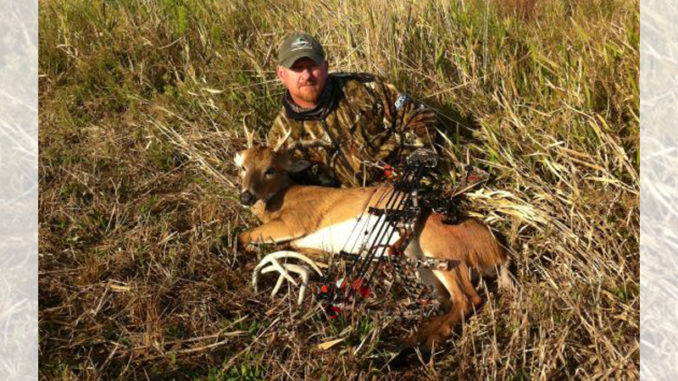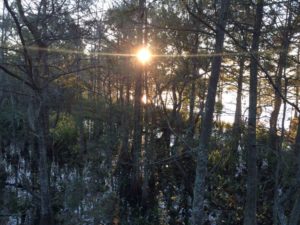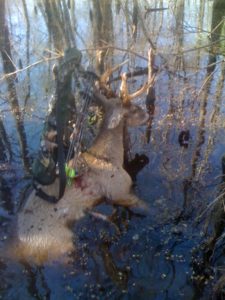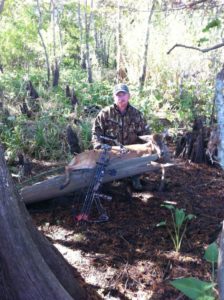
Pursuing bucks in the marshes of Louisiana isn’t for the faint of heart. But tough, uncomfortable conditions weed out lots of hunters, and just about any deer is a trophy.
Gary Williams doesn’t consider himself a trophy deer hunter — but he definitely enjoys the challenge of harvesting his own meat.
Besides, his stomping grounds are deep in the marshes of Lacassine National Wildlife Refuge — an area that isn’t particularly well known for producing trophy whitetails.
But when the season opened back in October of 2001, Williams laid his eyes on an 8-point that haunted his thoughts. For the first time in his life, he was consumed by buck fever — and he was determined to hunt the deer down before the refuge closed for the season at the end of the month.
“I saw him while hunting one afternoon, and of course my heart was beating out of my chest,” said Williams, of Hayes. “I squeezed off a shot, but it was about 3 inches farther back than I wanted it to be because I was so nervous.”
After a short track through the marsh, Williams found the deer, with a solid double-lung shot despite his worries.
The buck ended up scoring 133 ⅞, which is still one of the largest deer ever harvested on the refuge. To date, it’s also still Williams’ biggest buck.
Despite the reputation Louisiana’s marsh gets for producing poor-quality deer, Williams said the area — especially Lacassine — is fruitful if you know how to hunt it.
“Most of the big bucks out there die of old age because they’re so hard to hunt,” he said. “From the mosquitoes and the heat to the wide open marsh, it’s tough hunting.”
Braving the elements

Lacassine NWR was established in 1937, comprised of almost 35,000 acres of freshwater marsh and a few natural ridges and levees. The area was set aside for the millions of waterfowl that winter along the coast each year. Eventually, archery hunting was allowed during the month of October (which was recently extended into November), when it closes as waterfowl season begins.
Williams has hunted the refuge for more than 40 years along with a few other regulars. The small group who brave the elements — and embrace the tough hunting — for a few weeks in the early fall have formed a close-knit bond over the years. Chris Myers, from Jennings, first met Williams years ago when he was a teenager. He’s been going back for 22 years now.
“I hunt by myself,” Myers said, “but I can have 10 guys come help me if I need them to. The camaraderie is special, and so is the challenge. It’s only bowhunting and you can’t just sit in a box stand. Out there, any deer is a trophy.”
A typical morning for Myers begins a few hours before sunrise with a boat ride, usually through dense fog on the Intracoastal Canal or Lacassine Bayou. Being so far south, coastal storms are the norm and pop up out of nowhere. After the boat ride, he trudges through the marsh grass that can grow a foot above his head. Hip boots and at times chest waders are necessary to access the interior marsh where he said most of the deer congregate.
“There’s very little hard land out there,” he said. “There are spoil banks every now and then. Most hunters go out there and hunt on what little hard land there is, but that doesn’t do anything but push those deer into the marsh. The deer are comfortable out there and acclimated to it.”
The ridges are home to a few trees like the occasional oak or honey locust. There are groups of willow trees and small stands of bald cypress interspersed throughout the low-lying marsh. Most of the property, though, is comprised of grass like roseau cane and marsh peas, the latter of which is a food source for whitetails. Deer will also eat American beautyberry, alligator weed and blackberry vines, all of which can be found scattered around Louisiana’s coastal marshes.
Then, there’s “flotant,” or floating marsh grass, which grows in patches on the surface of the water. It’s a tangle of roots and peat, tricky to maneuver through and often can’t hold the weight of a person. The water underneath can be anywhere from ankle deep to a few feet. The ruggedness of the terrain demands ingenuity.
“When I was working in Colorado I saw some snowshoes and got an idea,” Williams said. “I bought a set and cut the spikes off. I used them on the flotant and walked across that marsh like I was on dry ground.”
The terrain can also make it difficult to pinpoint exactly where deer are. But to the trained eye, Williams said a good hunting location is immediately apparent. He’s not solely focused on food sources because they’re so abundant. Instead, he examines the grass near him.
“I’m looking for disturbed duckweed,” he said. “It’s normally a bright green plant on top of the water. When a deer walks through an area multiple times, the duck weed will be disturbed and flipped up. It changes color sightly and won’t be as bright.”
Blood trail challenges

When it comes to blood trailing, the key is also in the grass. Myers said due to all of the water, there’s never usually a clear blood trail to follow.
“A lot of time, the water is halfway up their bodies, if not covering their whole body,” he said. “That wound is under water. So the fresh sign is not blood, but mud and water splashed on the grass, or grass that’s separated.”
Williams said most of the time a wounded deer will run into the marsh rather than dry land. They’ll cross canals and cover a lot of ground quickly, which can make it difficult to keep on the trail.
“You can hear them running through the water and grass,” he said. “If I hear running and it stops and I hear a noise in the grass, he crashed. Just because you don’t see blood doesn’t mean you didn’t kill him.”
Since the grass is so tall and there are few trees around, it can be difficult to use a tree stand. If there are any available, Myers will use a lock-on or a ladder stand. Most aren’t straight, so a climber won’t do the trick.
Williams, on the other hand, sticks mostly to ground blinds deep within pockets of grass. He typically can’t see very far, usually only the tips of grass for hundreds of yards. He’s learned to use binoculars to glass his surroundings.
“If deer are moving through there, you will see the grass moving,” he said. “That gives you a point of reference to see which way they are traveling. You can then know when they are getting close and know you’ll get a shot soon.”
Close-quarter kill shots

Most of the shots in the marsh are within 20 yards, Williams said. Getting a deer that close requires concealment and scent control. He said being cognizant of wind direction is paramount, as is being alert throughout the hunt.
“You have to be prepared before the moment arises,” he said. “Sometimes you won’t hear them walking through the water. Expect that shot opportunity to be as close as 10 yards away.”
However, even sitting still isn’t so easy in the marsh, where warmer temperatures and plenty of standing water create a breeding ground for mosquitoes and gnats. While a Thermacell and DEET can help to control the swarms of mosquitoes, it’s best to carry a head net, paired with long sleeves and gloves, to keep the gnats away.
“You might have thousands of gnats on you so bad that you can’t open your mouth because they’ll fly in,” Williams said. “They go up your nose and in your ears. You have to make sure to cover up so you can deal with them.”
Sure, hunting the marsh isn’t for the faint of heart. But both Williams and Myers spoke of the challenges more like badges of honor than hardships. Having been born just a stone’s throw from Lacassine, the place is like home for them, more than any other public hunting ground in the state.
“It’s something I’ve been doing for 40 years,” Williams said. “I can hunt anywhere in the country. I go out of state to hunt a lot. But I like hunting in the marsh more than anywhere. There’s nothing like sitting in silence and listening to the marsh, hearing those deer come through the water.”